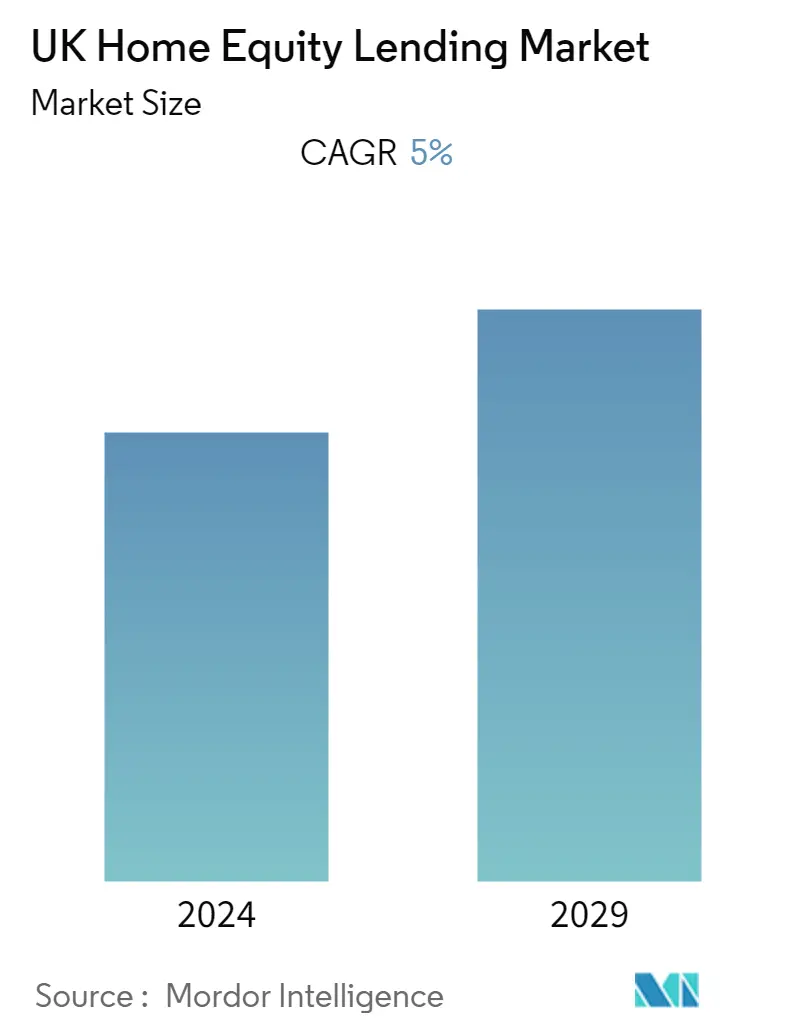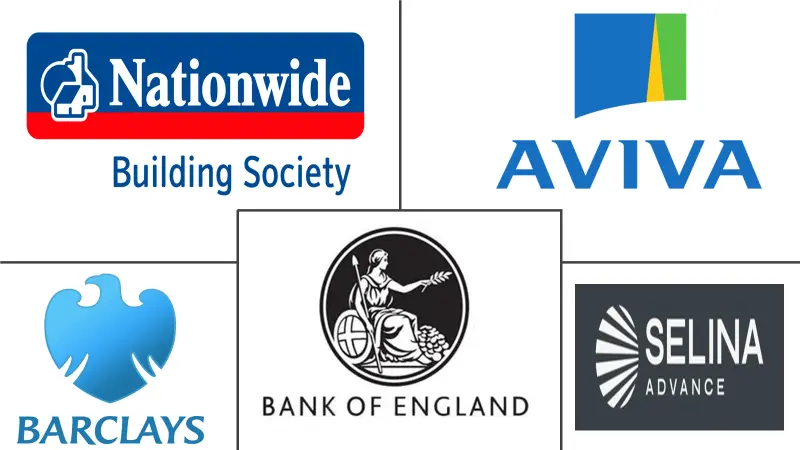Market Size of UK Home Equity Lending Industry

| Study Period | 2020 - 2029 |
| Base Year For Estimation | 2023 |
| Forecast Data Period | 2024 - 2029 |
| Historical Data Period | 2020 - 2022 |
| CAGR | 5.00 % |
| Market Concentration | Medium |
Major Players
*Disclaimer: Major Players sorted in no particular order |
UK Home Equity Lending Market Analysis
Many firms encountered uncertainty as a result of Covid-19, which resulted in job losses or reduced pay. As the crisis drags on, banks, credit unions, and other lenders continue to take a cautious approach to lend, putting some of their products on hold. The Home Equity lending market especially Home Equity line of credit (HELOC) is impacted by the Corona-virus pandemic. During the COVID-19 pandemic, some of the country's top banks declared that they would no longer be accepting new HELOC applications.
Homeownership in the United Kingdom was at a declining state since early 2000. The highest homeownership in the early 2000s had hit low after the global financial crisis. There have been some signs of improvements and homeownership is recovering slightly in the last couple of years. The number of UK citizens investing in 'buy to let property has increased dramatically over the past year. Property has become a popular alternative to traditional investments and pensions, as it provides both rental income and capital growth. Buying the investment property is tough and requires a large cash reserve. It is a slow process and needs a cash reserve of 20-30 % of the total investment so, Investor are utilizing the home equity lending and home equity line of credit for investment in property. A home equity line of credit may be a preferable option for an investment property if the investor can agree on the amount to be borrowed and then withdraw the funds only when needed. Once an investor has located an investment property, they can borrow the funds they need - for a deposit, a cash purchase, or to cover costs - and only pay back the funds after they have utilized them. Home equity loans of credit are generally flexible, allowing the borrower to repay the loan and redraw it at a later period. So, if an investor purchases an investment property, he or she can develop it and resell it, and can use the proceeds from sale to repay the home equity line of credit.
UK Home Equity Lending Industry Segmentation
Home equity lending allows homeowners to get credit based on how much equity they have in their homes. Lenders normally allow homeowners to borrow up to 80 percent of their home equity in a lump sum, which may be a big figure for those who have paid off a major portion of their mortgage or who own their property outright. This report aims to provide a detailed analysis of Home equity lending in the United Kingdom. It focuses on the market dynamics, emerging trends in the segments, the future of markets, and insights on various drivers and restraints. Also, it analyses the key players and the competitive landscape in the market. The UK Home Equity Lending Market can be segmented by Types, (Fixed Rate Loans, Home Equity Line of Credit (HELOC)), By Service Provider, (Banks, Building Societies, Online, Credit Unions and Others), and by Mode (Online and Offline).
| By Product Type | |
| Fixed Rate Loans | |
| Home Equity Line of Credit |
| By Service Provider | |
| Banks | |
| Building Societies | |
| Online | |
| Credit Unions | |
| Others |
| By Mode | |
| Online | |
| Offline |
UK Home Equity Lending Market Size Summary
The UK home equity lending market has experienced significant challenges and transformations, particularly influenced by the COVID-19 pandemic. The pandemic led to a cautious lending approach by banks and credit unions, impacting products like Home Equity Lines of Credit (HELOCs). Despite these challenges, there has been a gradual recovery in homeownership rates in the UK, which is a positive indicator for the home equity lending market. The trend of investing in 'buy to let' properties has gained momentum, as property investment offers a viable alternative to traditional investments, providing both rental income and capital growth. Investors are increasingly utilizing home equity lending to finance these property investments, leveraging the flexibility of HELOCs to manage their cash reserves effectively.
The market for home equity lending in the UK is characterized by a fragmented landscape, with services offered by high-street banks, online banks, building societies, credit unions, and other financial institutions. While home equity loans are available, HELOCs are more prevalent. The market has seen notable developments, such as Selina Advance's significant investment to expand its home equity lending solutions across the UK. However, some major players, like Santander, have ceased originating new residential mortgages and HELOCs, although they continue to service existing ones. The availability of home equity for release remains substantial, providing homeowners with potential financial leverage for retirement and other investments.
UK Home Equity Lending Market Size - Table of Contents
-
1. MARKET INSIGHTS AND DYNAMICS
-
1.1 Market Overview
-
1.2 Market Driver
-
1.3 Market Restraints
-
1.4 Porters 5 Force Analysis
-
1.4.1 Threat of New Entrants
-
1.4.2 Bargaining Power of Buyers/Consumers
-
1.4.3 Bargaining Power of Suppliers
-
1.4.4 Threat of Substitute Products
-
1.4.5 Intensity of Competitive Rivalry
-
-
1.5 Insight on Technologial Adoption in the Market
-
1.6 Insight on Various Government Regulations in the Market
-
1.7 Impact of Covid 19 on market
-
-
2. MARKET SEGMENTATION
-
2.1 By Product Type
-
2.1.1 Fixed Rate Loans
-
2.1.2 Home Equity Line of Credit
-
-
2.2 By Service Provider
-
2.2.1 Banks
-
2.2.2 Building Societies
-
2.2.3 Online
-
2.2.4 Credit Unions
-
2.2.5 Others
-
-
2.3 By Mode
-
2.3.1 Online
-
2.3.2 Offline
-
-
UK Home Equity Lending Market Size FAQs
What is the current UK Home Equity Lending Market size?
The UK Home Equity Lending Market is projected to register a CAGR of 5% during the forecast period (2024-2029)
Who are the key players in UK Home Equity Lending Market?
Barclays Bank, Bank of England, Selina Advance, Aviva and Nationwide Building Society are the major companies operating in the UK Home Equity Lending Market.

